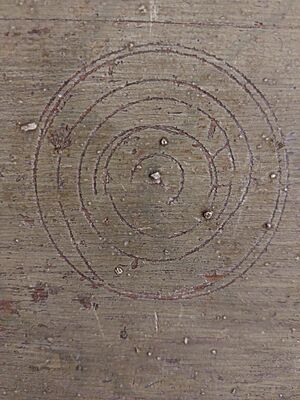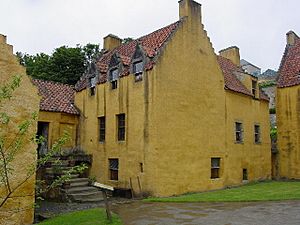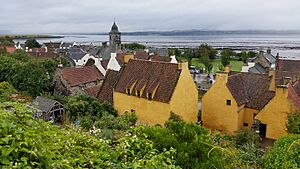Culross Palace facts for kids

Culross Palace is a fascinating old house in Culross, Fife, Scotland. It was built a long time ago, between the late 1500s and early 1600s. Even though it's called a "palace," it was actually the home of a very successful merchant, not a king or queen!
Contents
A Merchant's Grand Home
Who Built Culross Palace?
The palace, also known as the "Great Lodging," was built by a man named Sir George Bruce. He was the Laird (which means a Scottish landowner) of Carnock. He started building the main part of the house in 1597. Then, in 1611, he added another section. This was the same year he was made a knight!
Sir George Bruce's Business
Sir George Bruce was a very clever and successful businessman. He traded goods with many places, including other ports along the Firth of Forth (a large sea inlet in Scotland), the Low Countries (like modern-day Netherlands and Belgium), and Sweden. He was involved in many different businesses, such as coal mining, making salt, and shipping. He even sent ships to Spain to bring back wine! Sir George is famous for something amazing: he is believed to have created the world's first coal mine that went deep under the sea.
Building Materials from Far Away
Many of the materials used to build Culross Palace came from far-off lands because of Sir George's trading. For example, the strong pine wood came from the Baltic region. The red roof tiles, called pantiles, and the floor tiles and glass came from the Netherlands. The outside of the palace has special stepped gables, which are like stair-shaped parts of the roof. You can even see a statue of a veiled woman on one of these gable steps!
Inside the Palace
Beautiful Decorations
The inside of Culross Palace is just as impressive as the outside. It has beautiful decorations, including painted walls and amazing painted ceilings. These ceilings are a great example of Scottish Renaissance art. The palace also has furniture from the 17th and 18th centuries. You can see a wonderful collection of pottery from places like Staffordshire in England and from Scotland itself.
Special Ceiling Paintings
On the second floor of the south part of the palace, there's a ceiling painting with 16 special pictures called emblems. These emblems were inspired by a book from 1586 called A Choice of Emblemes by Geffrey Whitney. In the north part of the palace, you can still see parts of a painting that shows the story of the Judgement of Solomon. There are also many other original decorative paintings throughout the house.
The Palace Today
A Royal Visitor
Even though Culross Palace was never a royal home, King James VI of Scotland (who later became James I of England) visited it in 1617.
Looking After the Palace
Today, Culross Palace is looked after by the National Trust for Scotland. They have done a wonderful job of bringing it back to how it would have looked in the 1600s.
The Historic Garden
The palace has a beautiful garden that has been restored to look like a 17th-century garden. It has raised beds for plants, a covered walkway, and paths made of crushed shells. The herbs, vegetables, and fruit trees growing in the garden are all types that would have been used in the early 1600s.
Restoring the Art
The amazing painted artwork inside the palace has been carefully restored twice. The first time was in 1932, and then again in the 1990s by experts from Historic Environment Scotland.
External links
- Culross Palace - official site at National Trust for Scotland
- Engraving of nearby Culross House in 1693 by John Slezer at National Library of Scotland



